The cause of Tonga's record-breaking tsunami has been revealed.

The tsunami caused by the Hunga Tonga-Hunga Ha'apai eruption at the start of 2022 affected various nations in Oceania, Asia, North America, and South America, with waves reaching 15 meters (49 feet) in some places - the disastrous result of a record-breaking volcanic shockwave.
Understanding the Mechanism
New research has uncovered the mechanism that scientists believe caused the tsunami to go so far and with such energy - a phenomenon is known as acoustic-gravity waves (AGWs), which are a particularly long form of sound wave that can move extraordinarily swiftly across the water or the air.
When the volcano explosion progressed, these AGWs reportedly went through the water, up into the sky, and then out across the waves. As several waves collided, they provided even more energy to the eventual tsunami.
This meant that the tsunami grew in size, lasted longer, and went farther and faster than it would have otherwise.
"The idea that atmospheric waves triggered by volcanic eruptions could generate tsunamis is not new," says geologist Ricardo Ramalho of Cardiff University in the United Kingdom. "However, this event was the first recorded by modern, worldwide dense instrumentation, finally allowing us to unravel the exact mechanism behind these unusual phenomena."
The presence of these waves was determined using a mix of data gathered from sea level, the atmosphere, and satellite measurements. There was a "direct link" between the first symptoms of air disturbance caused by AGWs and the commencement of the tsunami in multiple sites.
Tonga Eruption

The Hunga Tonga-Hunga Ha'apai volcanic eruption was massive, although underwater eruptions seldom cause tsunamis of this magnitude. According to scientists, how AGWs stimulate the ocean-atmosphere interface was critical in driving such dramatic and devastating outcomes.
Various violent events may cause AGWs; as the name implies, they are impacted by gravity. One of these waves can be hundreds of kilometers or miles long, travel thousands of meters or feet under the sea, and reach speeds near the speed of sound in water.
"The Tonga eruption occurred in an optimal place below the surface, in shallow water, resulting in energy being released into the atmosphere in a mushroom-shaped close to the sea surface," explains Cardiff University applied mathematician Usama Kadri.
"As a result, energetic AGWs interacting with the ocean surface was unavoidable."
Nonlinear Resonance
Nonlinear resonance occurs when AGWs interact with already-created tsunamis. The researchers believe this was a factor in transmitting energy back into the ocean and boosting the speed and severity of the tsunami even further.
According to the researchers, the tsunami moved 1.5-2.5 times faster than a typical volcano-triggered tsunami, reaching speeds of over 1,000 km/h (621 mph) as it swept across the Pacific, Atlantic, and Indian seas in less than 20 hours.
Furthermore, because it was moving part through the atmosphere, the tsunami reached the Caribbean and Atlantic without circumnavigating South America. There appears to be a lot more science we can learn from this historic occurrence.
"Such a resonance at this size allows us to proceed beyond the mechanism's proof of concept and create more accurate forecasting models and real-time warning systems towards the possibilities of inventing a new energy harvesting technology," adds Kadri.
Related Article : Experts are Studying the "Biggest Earthquake in Human History"
For similar news, don't forget to follow Nature World News!
© 2025 NatureWorldNews.com All rights reserved. Do not reproduce without permission.





